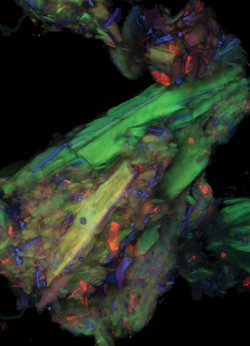Pictures explain results
Fluorescence imaging and spectroscopy have provided our scientists with new insights into the molecular interaction that takes place during the conversion of softwood biomass into simple sugars and lignin. This is a vital step in the production of biofuels and biochemicals.
Softwoods, such as radiata pine, are technically challenging to convert into sugars. To overcome this, Scion’s biofuels researchers developed an enzyme-based process that breaks down the cellulose and hemicellulose components in pre-treated wood, into simple sugars. These sugars can then be fermented into biofuels such as ethanol or converted into biochemicals.
Until recently, the effectiveness of this process was limited by the enzymes binding unproductively with lignin instead of the cellulose and hemicellulose, but experiments by our researchers have found this can be improved by adding small amounts of additives, such as polyethylene glycol (PEG).
The results can now be explained visually at a molecular level. By using fluorescence imaging, researchers have been able to show that PEG binds more strongly with lignin than the enzymes do, freeing up the enzymes to work their magic on the sugars.

Steam exploded wood showing fluorescence of lignin (blue), cellulose (green) and cellulase enzyme (red).
For further information
Contact Dr Paul Bennett at Show email
